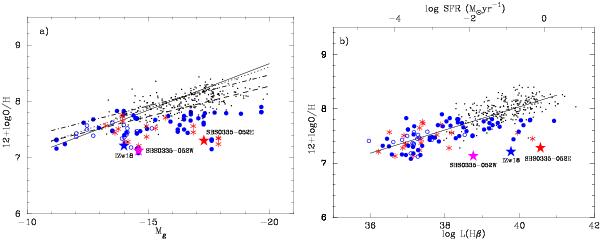Fig. 5

a) Absolute g magnitude–oxygen abundance relation. The emission-line galaxies from this paper are shown by large circles, the filled circles representing galaxies with element abundances derived by the direct method, and the open ones galaxies with element abundances derived by the semi-empirical method; the XMD emission-line galaxies of Izotov & Thuan (2007) are shown by red asterisks, and the SDSS galaxies of Izotov et al. (2006a) by black dots. The dashed line is the linear regression to all these data. The solid line is the relation derived by Skillman et al. (1989), the dotted line is the one derived by Richer & McCall (1995), and the dot-dashed line is the one derived by Berg et al. (2012). For comparison, the most-metal deficient BCDs I Zw 18, SBS 0335–052W and SBS 0335–052E are shown by blue, magenta and red stars, respectively, and labelled. b) Hβ luminosity–oxygen abundance relation. The symbols are the same as in a). The solid line is the linear regression to all data, excluding I Zw 18, SBS 0335–052W and SBS 0335–052E.
Current usage metrics show cumulative count of Article Views (full-text article views including HTML views, PDF and ePub downloads, according to the available data) and Abstracts Views on Vision4Press platform.
Data correspond to usage on the plateform after 2015. The current usage metrics is available 48-96 hours after online publication and is updated daily on week days.
Initial download of the metrics may take a while.


